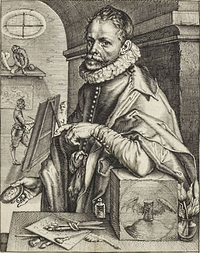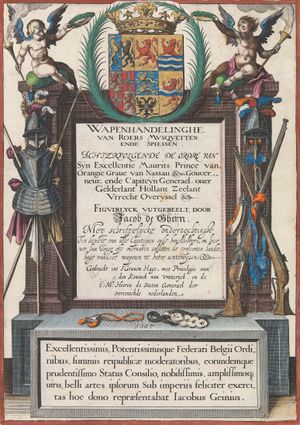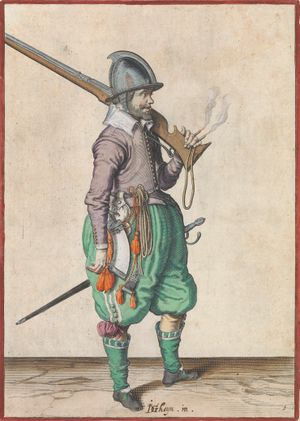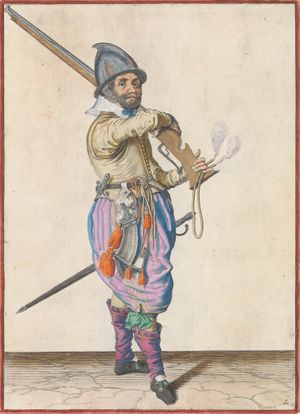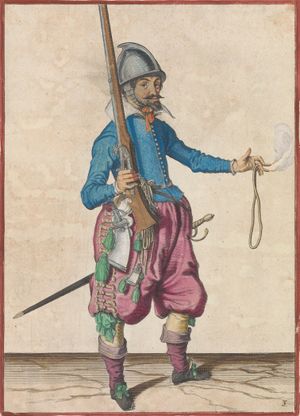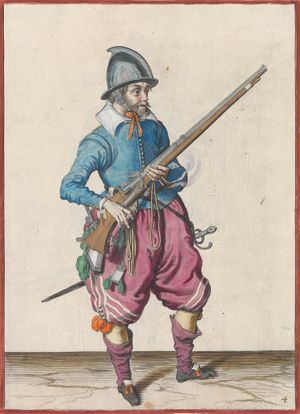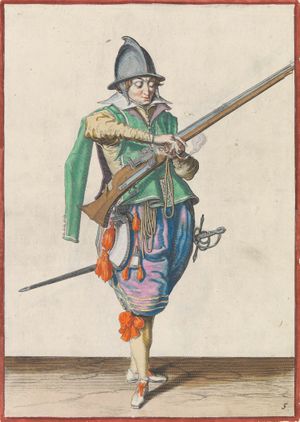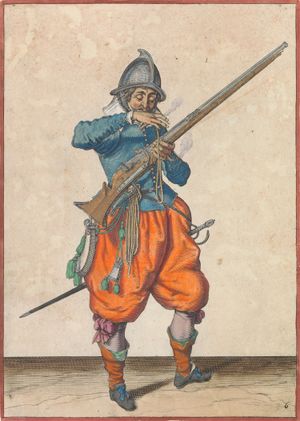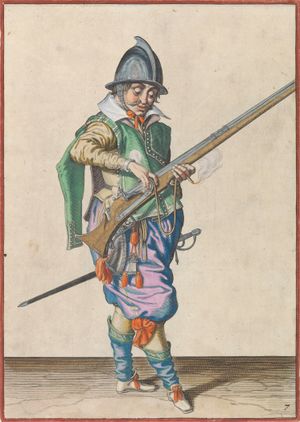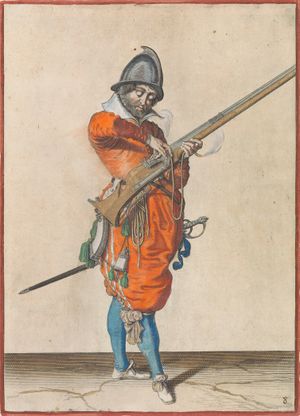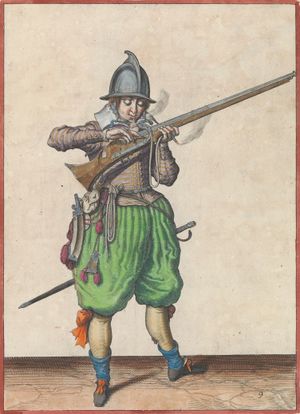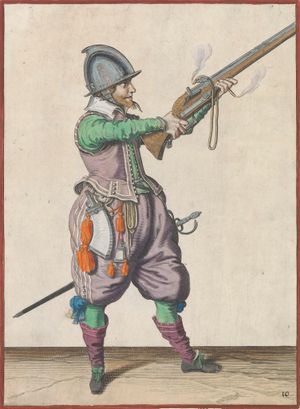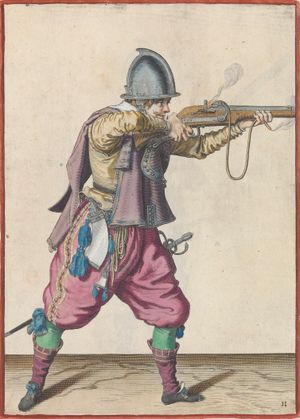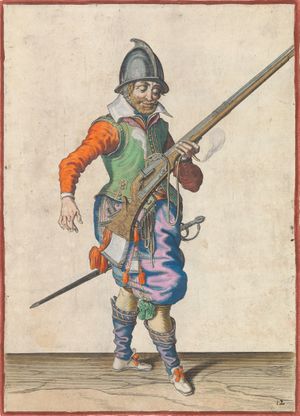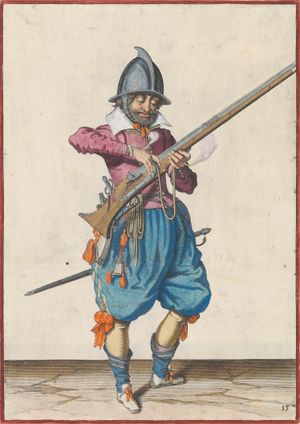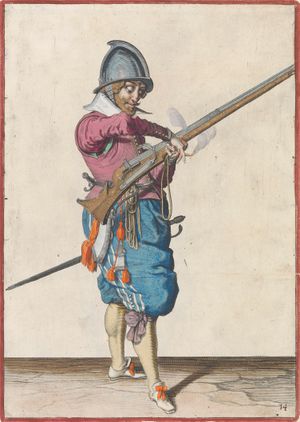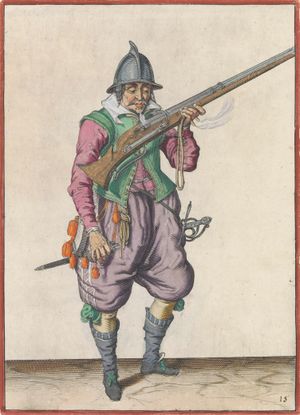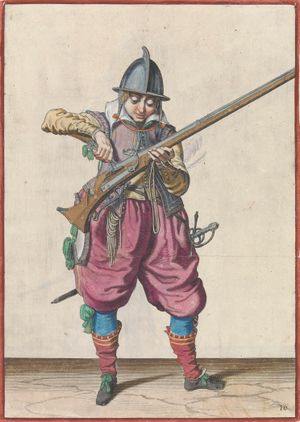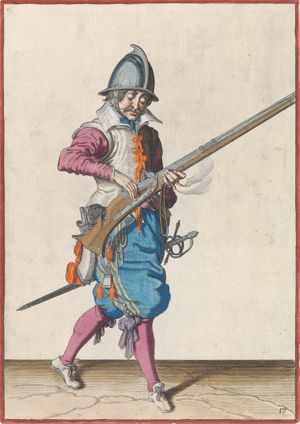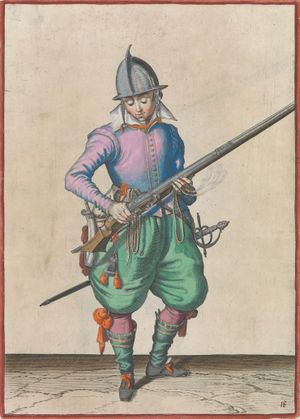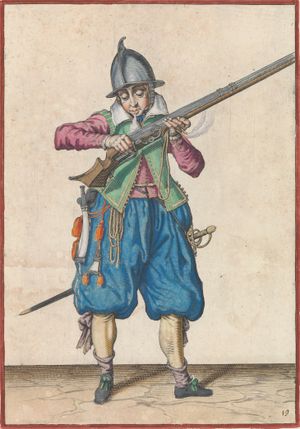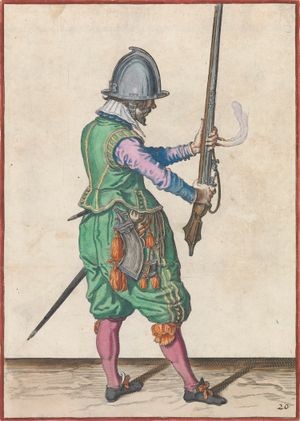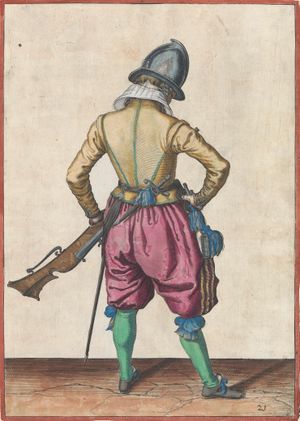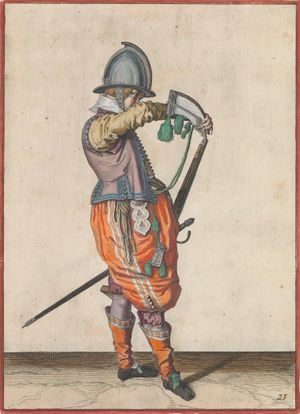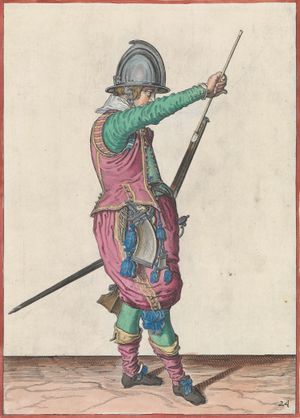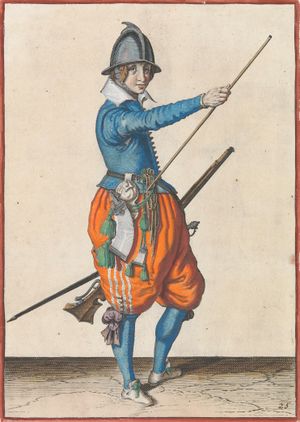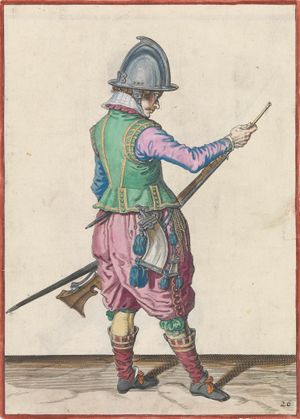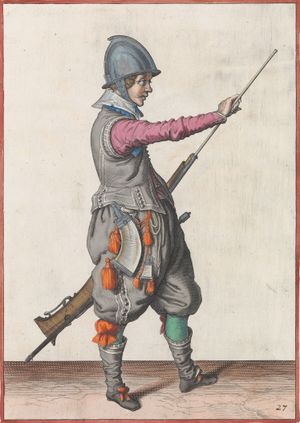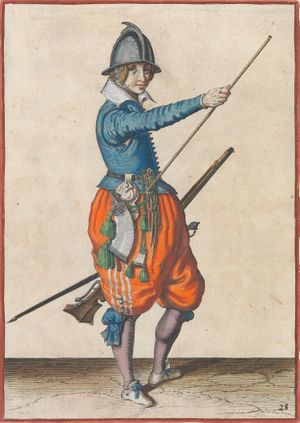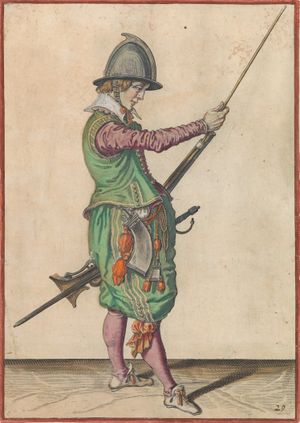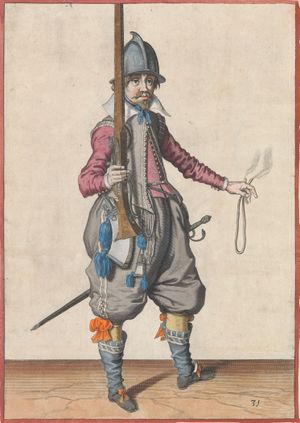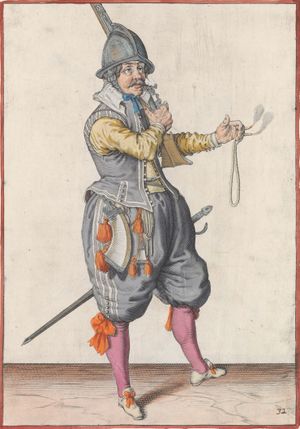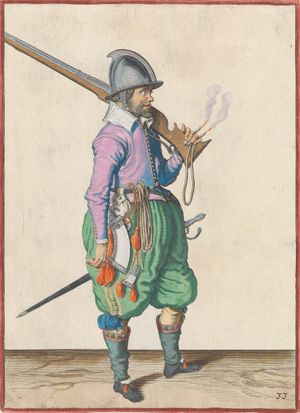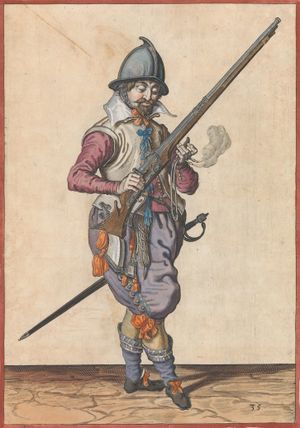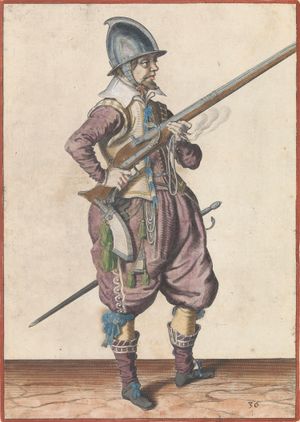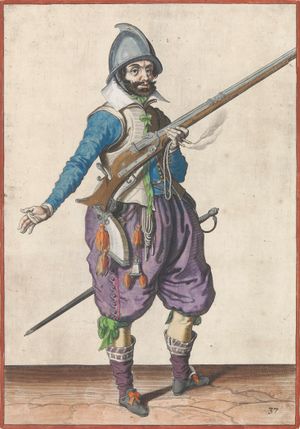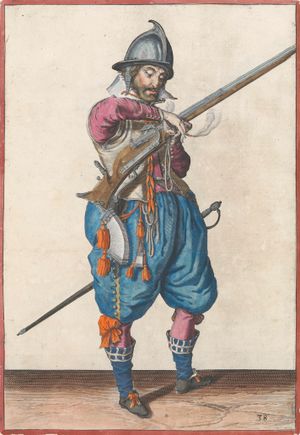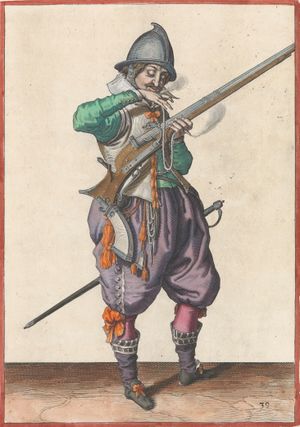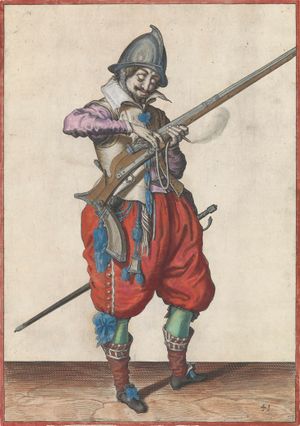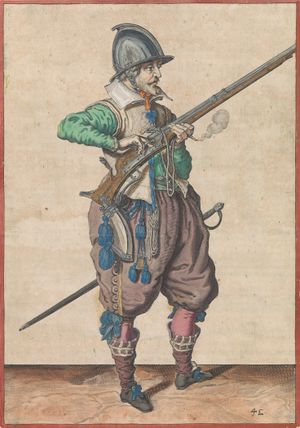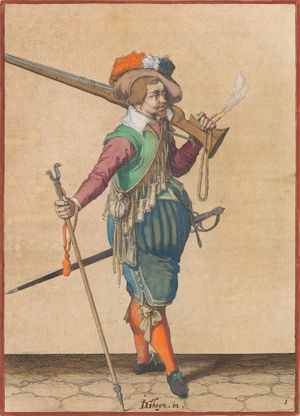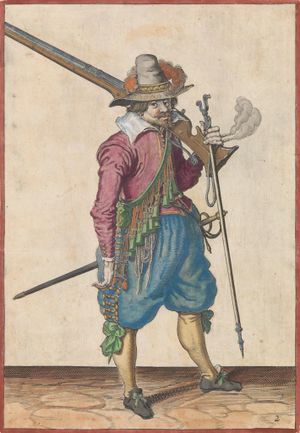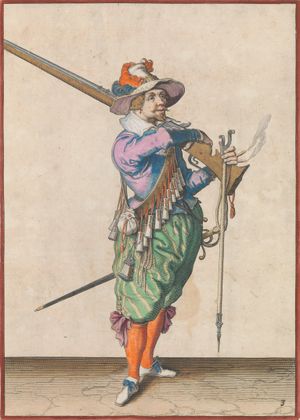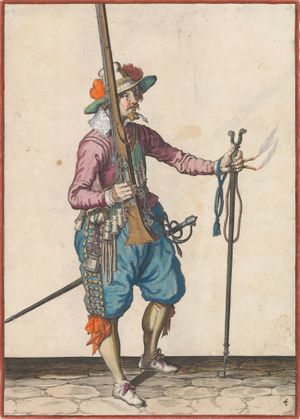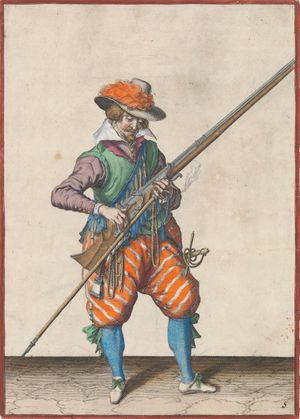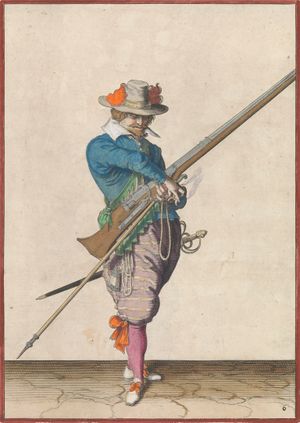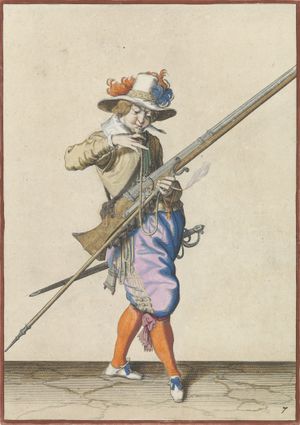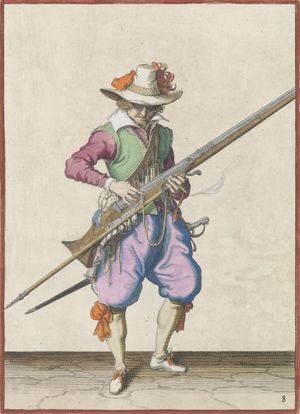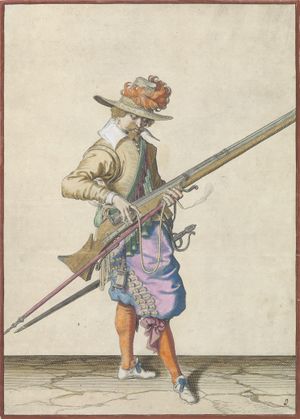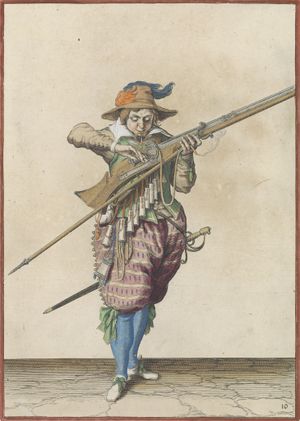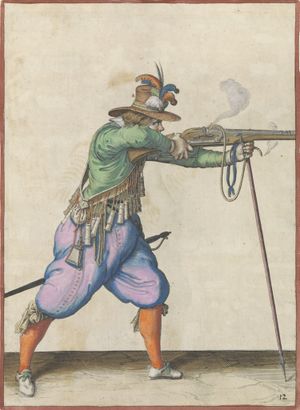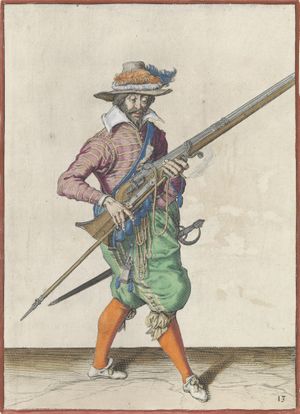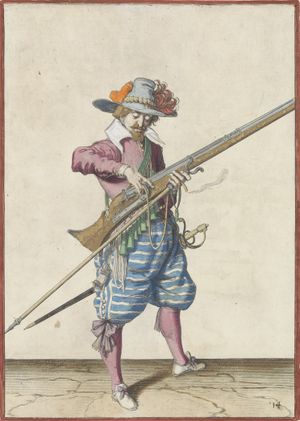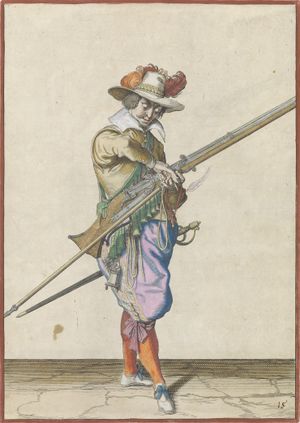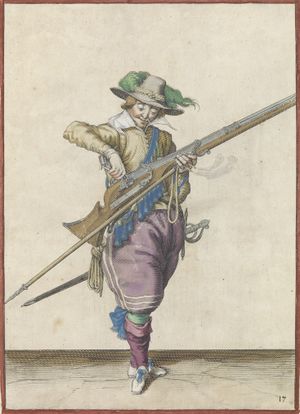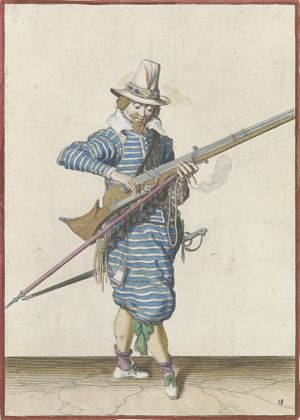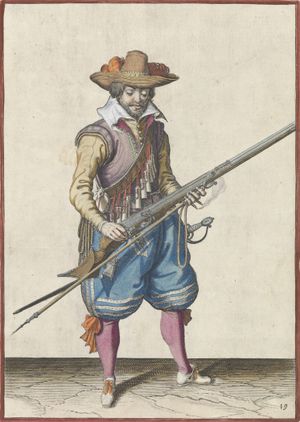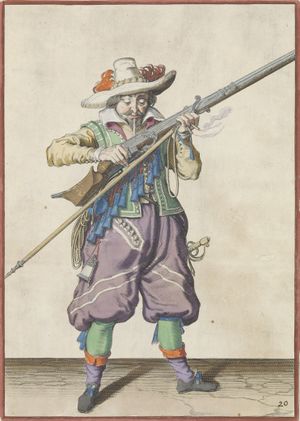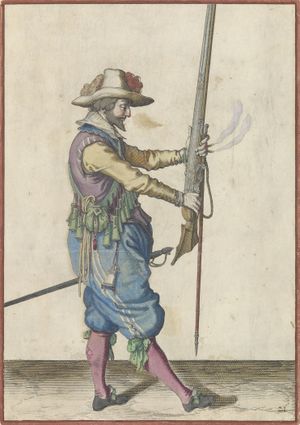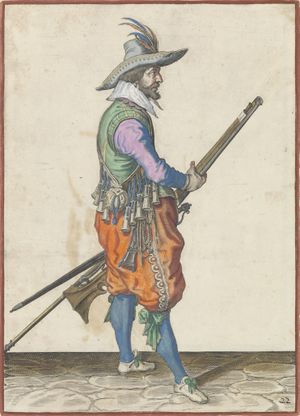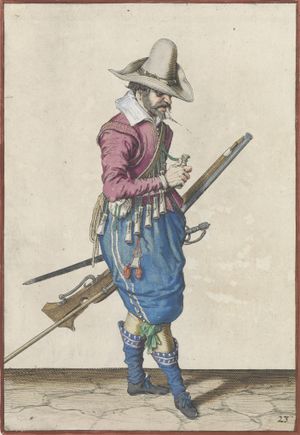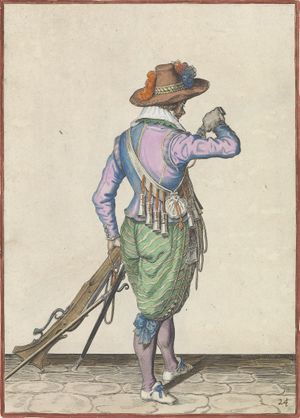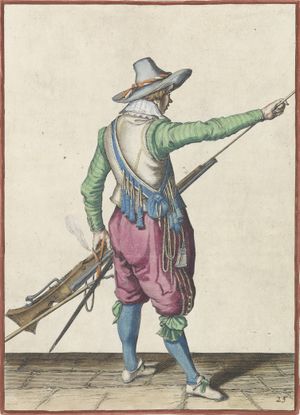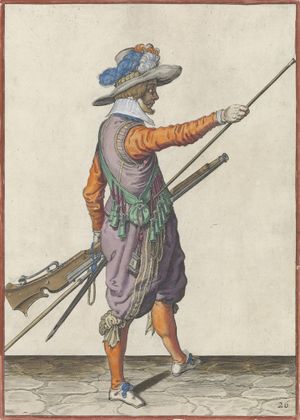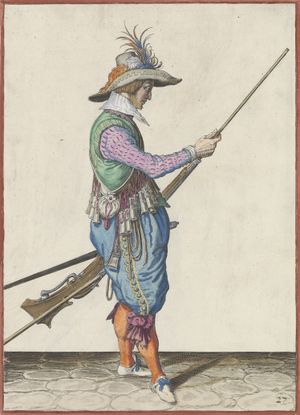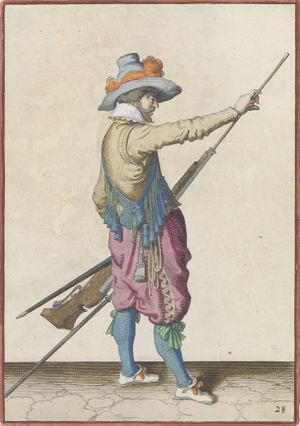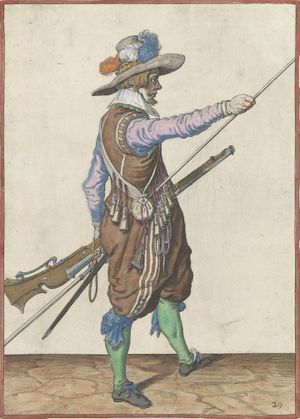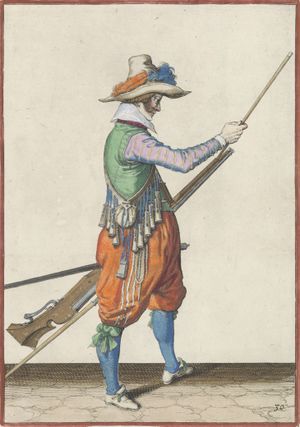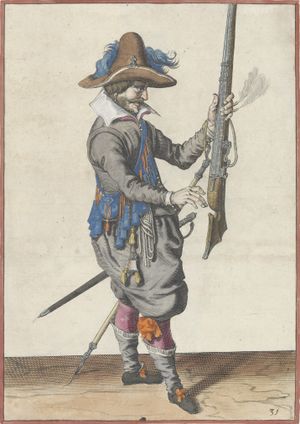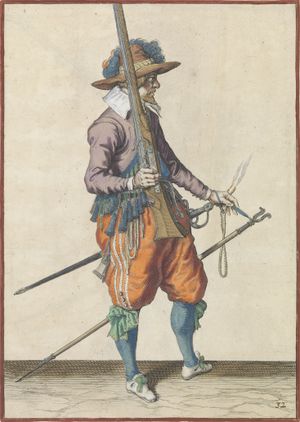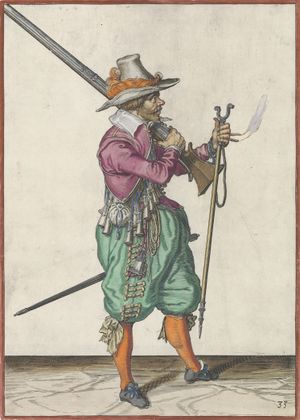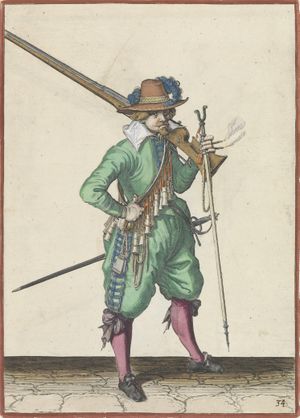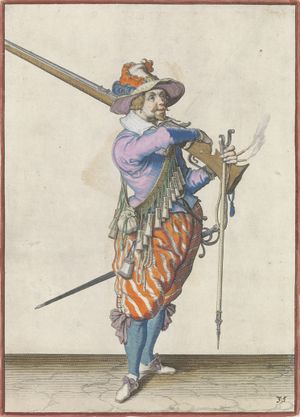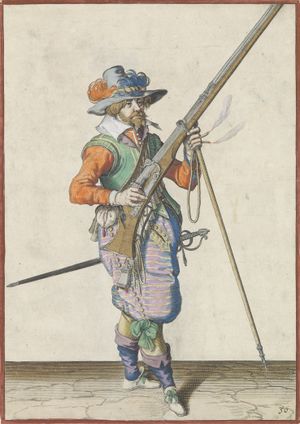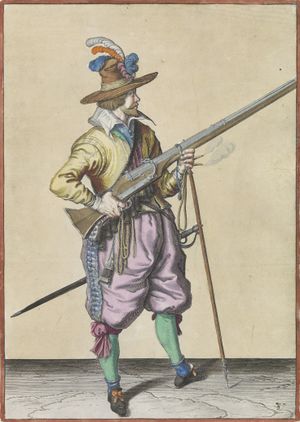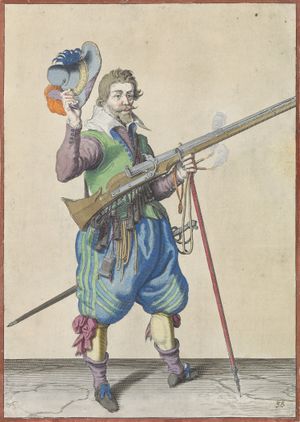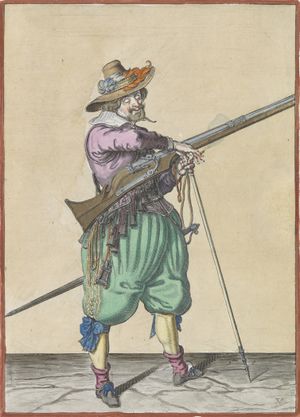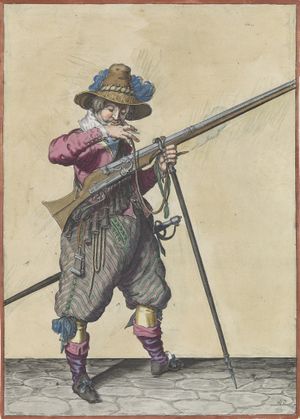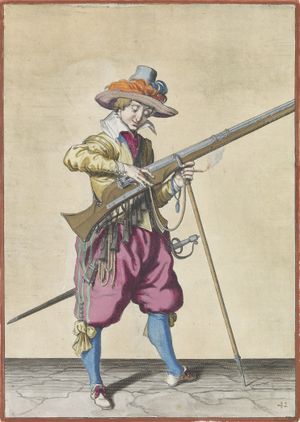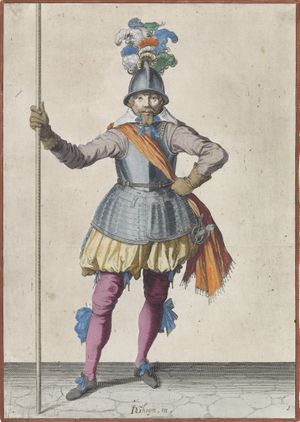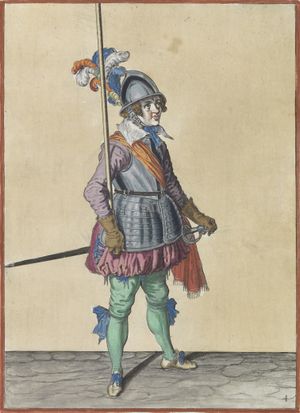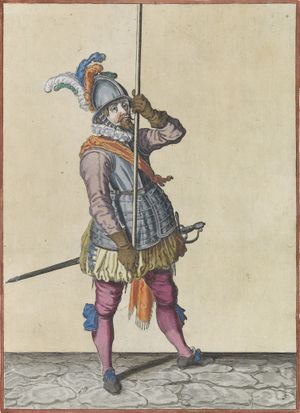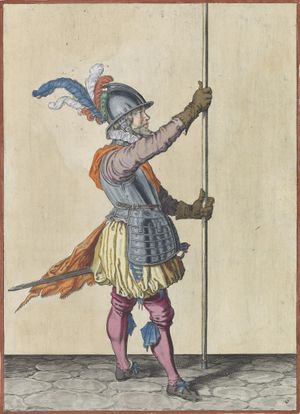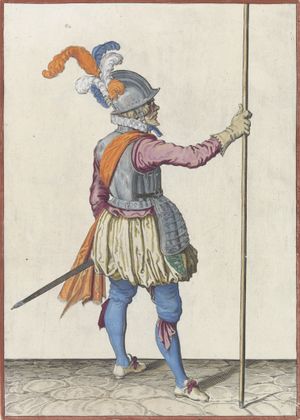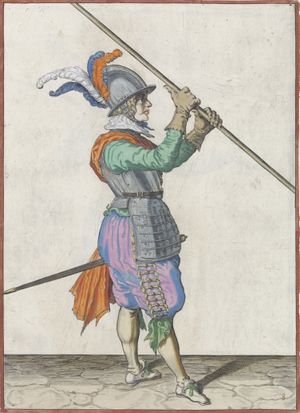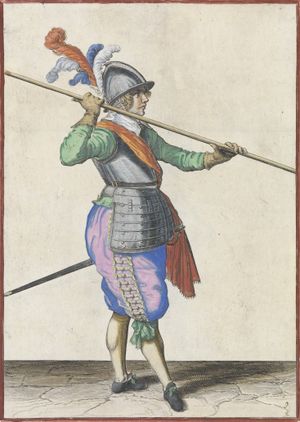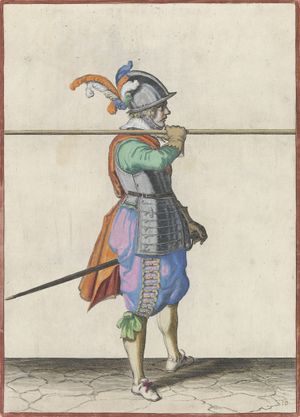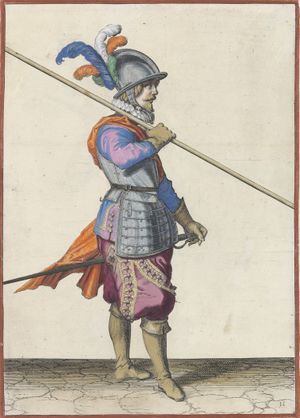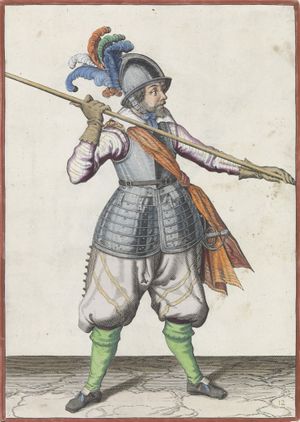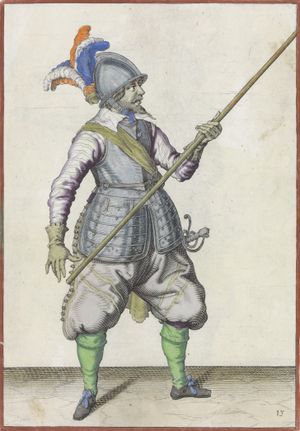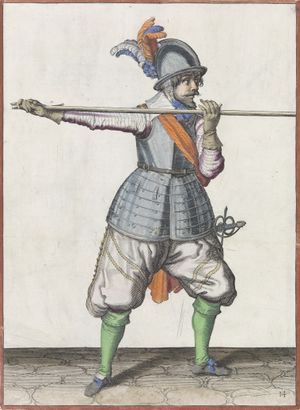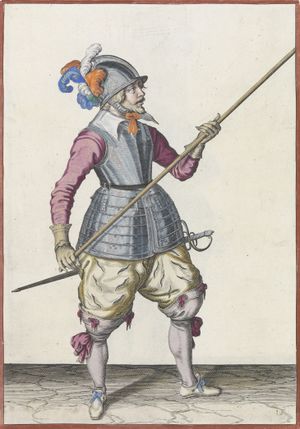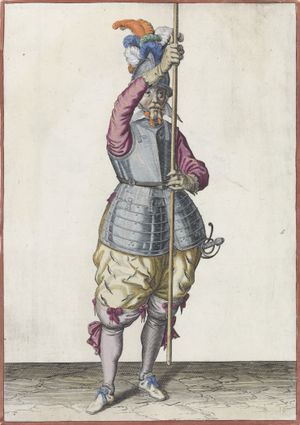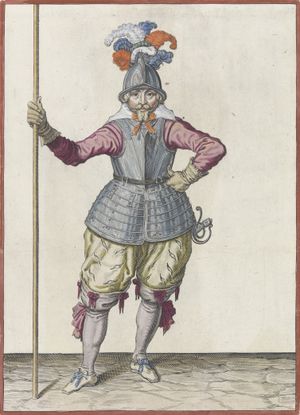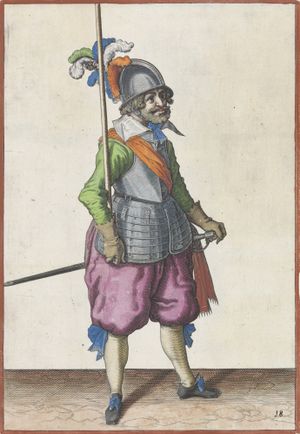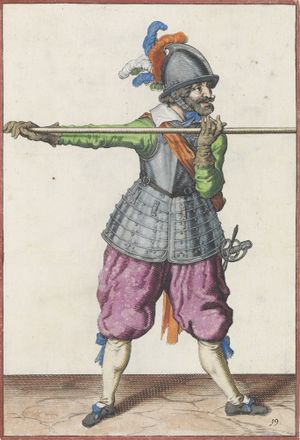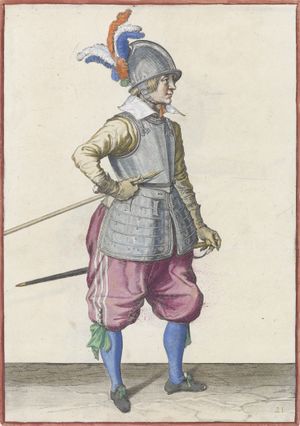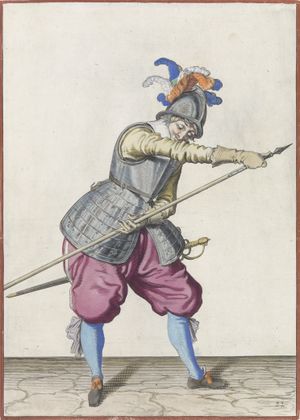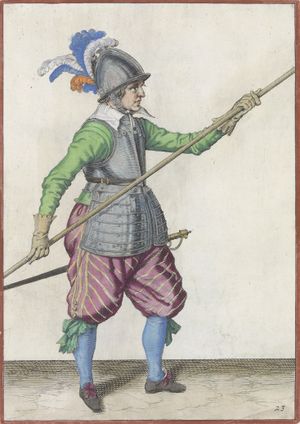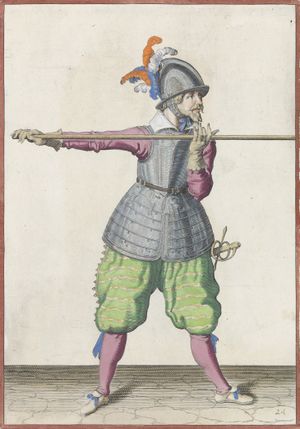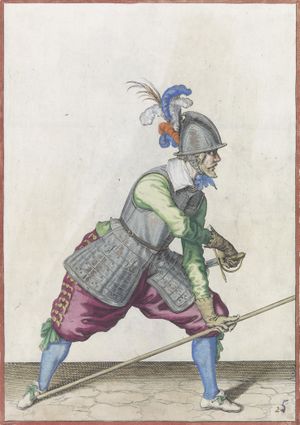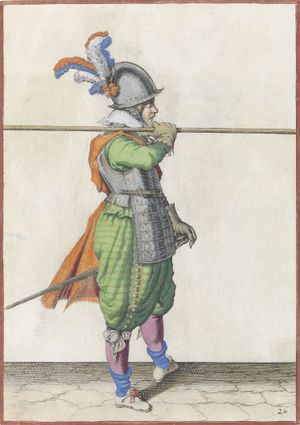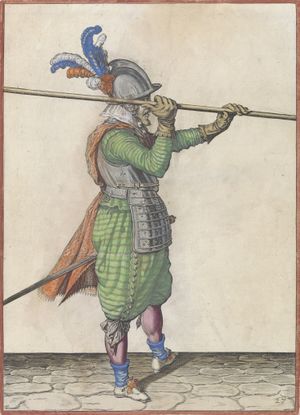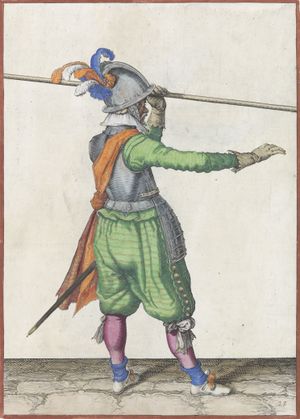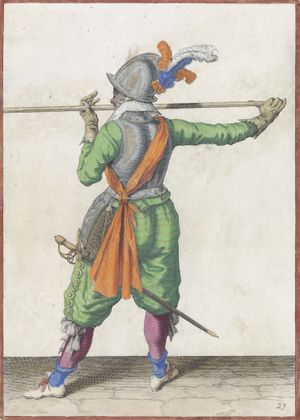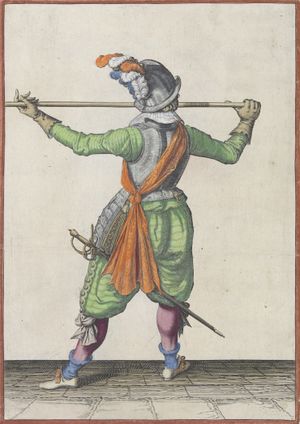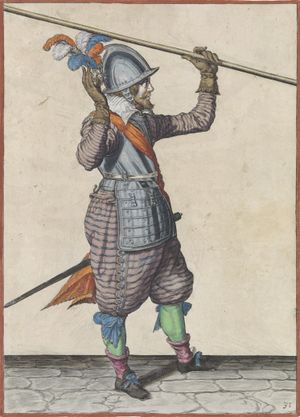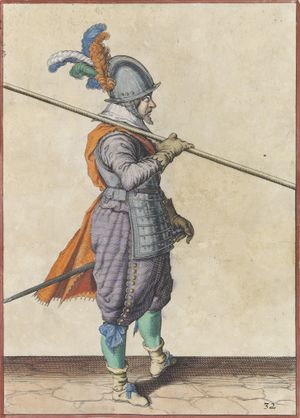Images
|
No Translation 
|
English Version (1607) [edit]
Transcribed by Michael Chidester
|
Danish Version (1607) [edit]
|
Dutch Version (1607) [edit]
Transcribed by Michael Chidester
|
French Version (1607) [edit]
Transcribed by Michael Chidester
|
German Version (1608) [edit]
Transcribed by Michael Chidester
|
|
|
|
[15] Brief Instruction upon the contrefaictinges, Concerning the Right Use, of All what a Souldier needeth to know in handling of the Pike, for the yonge or untrayned Souldier, which instruction agreeth by nomber with every figure in order.
|
|
[11] Corte onder wysinghe op de figuerlÿcke afbeeldinghe, belanghende t’recht ghebruyck, van al t’ghene een Soldaet int handelen vande Spies noodich is, voor de jonghe ofte onervaren Soldaten, welcke onderwÿsinghe by’t ghetal op elcke figure vervolghens is corresponderende.
|
[13] Enseignement brief, et succint sur les portraitz figurez, touchant l’usage, de tout ce qu’un Soldat doibt faire au maniement de la Pique, pour les jeunes Soldatz & inexperimentez, lequel se poursuyt par ordre, & correspondt sur chacune figure.
|
[181] Kurtze antzeigung und bestendiger beright / von den Figüerlichen abbildungen belangend den rechten brauch des Spiesses und alles des ienigen so einem Soldaten zuverstechen von nöten / insonderheit sur die junge unerfahrne Soldaten / welche unterweysung und lehr bey der zahl einer ieden figur nacheinander angedeūtet wirdt.
|
|
|
|
The words of Command. With the tyme of changeing of holde.
And seeing experience teatcheth, that the souldier can not speedely nor hansomely change the ordre of his Pike, but through knowledge how to handle and hold the same well, therefore are there, for his better instruction, certayne words of command hereby annexed together with the tymes of changeinge or remoovinge of the hands, which doe altogether agree both with the rules of instruction, as also with the Cypher numbers alloted to ech severall picture, to the ende that the Captaynes may shew or theatch theyr neew untrayned Souldiers the handlinge of the Pike after this manner, I meane so much as is necessary for theyr use, but havinge once obtayned the handling, the Souldier shall be then exercised with the words of command onely, wich words are set here after apart and without the distinctions of tymes, such as here immediatly follow.
|
|
De woorden van bevele. Met hun tÿden van hervattinghe.
Ende alsoo bevonden wort dat den Soldaet zÿn Spies niet wel noch verdichlÿck en can herstellen, dan door wetenschap vande selfde wel te connen handelen ende hervatten, soo zÿn tot onderwÿs vanden selfden hier by gheordineert, seeckere woorden van bevele met hun tÿden van hervattinghe die al te samen met ghetal op de figuren als oock op d’onderrechtinghe vervolghens zÿn corresponderende, op dat de Capiteynen hnn nieuwe ende onervaren Soldaten, op dese maniere het handelen vande Spies, soo veel hun van noode is, moghen doen leeren, maer de handelinghe hebbende, sullen de Soldaten gheoeffent worden achtervolghens de woorden van bevele, die hier naer alleen, ende sonder tÿden, op hun selven ghestelt zÿn.
|
Motz de commandement. Avec leurs temps de reprises.
Et comme il se trouve, que le Soldat ne peult promptement & bien replanter ou mettre bas la Pique, sans l’experience de la scavoir bien manier & reprendre, pour l’esclarassement de cecy, sont ordonnez certains mots de commandement avec leurs temps de reprises, qui correspondent en suyte sur les figures, a fin que les Capitaines puissent faire aprendre à leurs jeunes Soldatz & inexperimentez, ce maniement de la Pique autant quils en auront de besoing, mais ayant l’experience, le Soldat sera exercé, par les motz de commandement cy apres mis à part, & sans temps.
|
|
|
|
|
1. Your Pike standing downe advaunce in three tymes or motions.
In the using of the Pike is first shewed unto the Souldier how he (standing still) shall hold the Pike before him, governe it against the thumbe and take it up in three tymes, That is to saye: he shall not (for comelynes) set it with in or without the right foote, but just before him in the same line: well understanding that he is not bound to set the right foote alwayes before, His arme he shall hold not stretcht out butt a little bended and his hand about the height of his eyes.
|
|
1. U Spies neder staende, in dry tÿden opwaerts draecht.
Int exerceren vande Spies wort den Soldaet eerstelÿcken ghewesen, hoe hy stilstaende in ordeninghe de Spies voor sich wel houden ende teghens den duym regeren, ende in dry tÿden opwaerts draghen sal, als te weten hy en sal de Spies, welstaens halven binnen noch buyten den rechter voet setten, maer ghenoechsaem op de selfde linic, sonder nochtans dat hy ghehouden sy den rechter voet int stilstaen altÿt voor te stellen, den arm niet uvtghestrect maer een weynich gheboghen, ende de hant soo hooch alst ghesicht houden.
|
1. La Pique estant plantée, portez la hault en trois temps.
Ens’exerçeant es Piques, est monstré premierement au Soldat comme estant debout, en ordre, il tiendra bien la Pique devant soy, la conduira contre le poulce, & en trois temps, la portera droite, ou vers hault, savoir est, que (pour la bienseance) il ne posera point la Pique au dehors, ny au dedens du piedt droit, mais sur la mesme ligne, sans que touttes-fois, il soit tenu, (demeurant deboubt) davoir tousiours le piedt droit avançe, il tiendra le bras non trop esgaré mais quelque peu plié, & la main a la haulteur de la veue.
|
|
|
|
|
2. the first [Tyme or Motion.]
In the 2. figure is shewed, how, before the first changeinge of his holde, he shall with the right hand lift the Pike a little from the ground and take it sodainely againe with the left hand towardes the neather ende, leavinge so much lengthe belowe as he can affterwardes reatch well with the right hand, like as this figure doth teatche.
|
|
Ten 2. hoe hy voor de eerste hervattinghe, de Spies met de rechter hant een weynich vander aerden om hooch heffen sal, ende met eenen de selfde verdichlÿck (met de lincker hant) nederwaerts aen vatten, latende soo veel lenckte beneden, als hy hier naer met de rechter hant sal connen bereyeken, ghelÿck dese figuere bewÿst.
|
2. Comme a la premiere reprise, il levera la Pique quelque peu arriere de terre avec la main droite, & l’empoignera soudainement, vers le bas avec la main gauche, laissant dessoubz telle longueur quil y puisse aveindre, ou toucher la reprenant de la main droite, ainsi que se voidt, par ceste figure.
|
|
|
|
|
3. the second Tyme or Motion.
In the 3. how he, before the second changeinge of hold, shall lift up the Pike with the left hand and quickely with the right hand take the same at the ende.
|
|
Ten 3. hoe hy voor de tweede hervattinghe de Spies met de lincker handt om hooch heffen, ende met de rechter de selfde onder aent eynde (verdichlÿcken) vatten sal.
|
3. A la deuxiesme reprise il levera la Pique, de la main gauche, & l’empoignera promptement, au bout d’en bas avec la main droite.
|
|
|
|
|
4. the thirde [Tyme or Motion.]
In the 4. how, before the third changeinge of hold, (having joyned the Pike with the left hand against the right arme) he shall governe the same against the sayde arme and carry it up, or advanced.
|
|
Ten 4. hoe hy voor de derde hervattinghe, hebbende de Spies met de lincker hant teghens den rechter arm ghevoecht, de selfde inde rechter hant, teghens den selfden arm regieren ende opwaerts draghen fal.
|
4. Et a la troisiesme reprise ayant (de la main gauche) porté la Pique, contre le bras droit, il la prendra de la main droite, la rengera contre le mesme bras, & la portera droite ou hault.
|
|
|
|
|
5. Order your Pike. the first [Motion.]
In the 5. how (havinge carried the Pike advanced) he shall set the same downe upon the ground againe in three tymes, like as before, that is: he shall let the right hand with the Pike sinke a little together, and for the first changeinge of handes, with the left hand take the same upwards, like as this figure teatchet.
|
|
5. U Spies herstelt. eersten tÿt.
Ten 5. hoe hy hebbende den Spies opwaerts gedragē, de selfde weder in dry tÿden als vore, op der aerden neder setten sal, als te weten hy sal de rechter hant met de Spies t’samen een weynich laten sincken, ende de selfde met de lincker hant, voor de eerste hervattinghe, op waerts aen vatten, ghelÿck dese figure bewÿst.
|
5. Remettez, ou plantez la Pique. le premier Temps.
5. Comme ayant porté la Pique droite en trois temps, fault quil la remette de mesme en terre, savoir, il laissera couler quelque peu la main droite, vers bas avec la Pique, & la reprendra vers hault pour la premiere fois de la main gauche, comme demonstre la presente figure.
|
|
|
|
|
In the 6. how, to change the second hold, he shall let the Pike sinke with the left hand and with the right hand quickely take the same heigher, like as this figure sheweth.
|
|
Ten 6. hoe hy om de tweede hervattinghe te doen, de Spies met de lincker hant sal laten sincken, ende niet de rechter hant de selfde (met eenen) verdichlÿck hoogher vatten, ghelÿck dese figure bewÿst.
|
6. Pour faire la deuxiesme reprise, laissera aussi couler la Pique, ensemble avec la main gauche, & de la droite, la reprendra foudainment plus hault, comme l’enseigne ce portrait.
|
|
|
|
|
In the 7. how, at the third changeinge of holde, he shall governe the Pike with the right hand onely and set it againe upon the ground, as is taught in the first figure, and if he will then laye the Pike upon the shoulder, he shall doe that againe in three tymes, as followeth.
|
|
Ten 7. hoe hy inde derde hervattinghe de Spies met de rechter hant alleen regeren, ende weder als byde eerste figure gheseyt is, op der aerden nedersetten sal, ende willende als dan de Spies op schouder legghen salt selfde weder in dry tÿden gheschieden, als volghen sal.
|
7. A la troisiesme reprise, conduira la Pique, de la main droite seulement, & comme il est dit en la premiere figure, la replantera en terre, & l’a voulant mettre sur l’espaule le sera en trois temps comme s’ensuyt.
|
|
|
|
|
8. Shoulder your Pike and carrye it levell. the first [Tyme.]
In the 8 place is shewed, how, before the first changeinge of holde (havinge the Pike in the right hand) he shall let the same fall over a little against the thumbe and presently take it with the left hand close to the right hand, like as this figure sheweth.
|
|
8. U Spies op de schouder leght ende plat draecht. eerften tÿt.
Ten 8 hoe hy voor de eerste hervattinghe de Spies inde rechterhant hebbende de selfde tegens den duym een weynich sal laten overvallen, ende met eenen verdichlÿek de selfde met de linckerhant dicht onder de rechter aenvatten, ghelÿck dese figure bewÿst.
|
8. Mettez la Pique sur l’espaule & la portez platte. le premier Temps.
8. Pour la premiere reprise, ayant la Pique en la main droite contre le poulce, la laissera quelque peu tomber en arriere, & soudainemēt l’empoignera à bas de la main gauche, tout joingnant la droite, comme se voidt icy representé.
|
|
|
|
|
In the 9. how he (before the second changeinge of hold) shall bringe the Pike foreward with the left hand and with the right hand take hold backward, the more handsomely and gracefully to lay the Pike on the shoulder.
|
|
Ten 9. hoe hy voorde tweede hervattinghe de Spies met de lincker hant naer voren brenghen, ende met de rechter handt de selfde achterwaerts aenvatten sal, om de Spies alsoo bequaemlÿek op de schouder te legghen.
|
9. A la deuxiesme portant la Pique en avant avec la main gauche, l’empoingnera, promptement en arriere, de la droite, pour la mettre ainsi proprement sur l’espaule.
|
|
|
|
|
In the 10. how he (in the third changeinge of hold) shall carye the Pike levell upon the shoulder, hold the right arme up and the thumbe against the pike, not onely for fashions sake, but because he maye governe and carye the same the better.
|
|
Ten 10. hoe hy inde derde hervattinghe de Spies op de schouder plat dragen, den rechter arm om hooch, ende den duym teghen de Spies houden sal, ten eynde het niet alleen wel en stae, maer dat hy de selfde dies te beter regieren ende draghen can.
|
10. Et a la troisiesme reprise portant la Pique platte sur l’espaule, il tiendra le bras droit sur haulsé, le poulce contre la Pique, pour ce que cela est (non seulement bien seant) mais aussi que par ce moyen il la peult mieux regir, & porter,
|
|
|
|
|
In the 11. how he shall carye the Pike slopinghe to avoyd the danger of hurting on an other when they marche close: and in the next figure shall beshewed how he (carrying the Pike levell or slopinge) shall let the same sinke when soever he will come to porte or otherwayes charge the pike, and how he shall set the same at three tymes againe upon the ground, and desiring to laye the same upon the shoulder, shall doe it at three tymes, as is taught before, But when he carrieth the Pike advanced he shall charge the same at one tyme.
|
|
11. Schuyns u Spies draecht.
Ten 11. hoe hy de Spies schuyns draghen sal, om wanneermen dicht op een Marcheert d’een den anderen (met het punt) niet en soude beschadighen, ende sal inde naervolghende figuren ghewesen worden hoe hy, draghende de Spies schuyns ofte plat, de selfde in dry tyden sal laten sincken, wanneer hy de Spies door een Poort ofte andersins vellen wil, ende hoe hy in dry tÿden de selfde wederom op der aerden nedersetten sal, ende willende de selfde op de schouder legghen, sal t’selve (alst te voren ghewesen is) oock in dry tÿden gheschieden. Maer soo wanneer hy de Spies opwaerts draghet, soo sal hy die alleenlÿck in een tÿt vellen, ende daer naer wederom in een tÿt opwaerts dragen.
|
11. Portez la Pique debiais.
11. Comme il portera la pique debiais, a fin que (marchant en trouppe serrée) on ne s’entre offense de la pointe. Es figure suyuantes se monstrera, comme portant la Pique platte, ou debiais, il la fault en trois temps laisser couler, quand on la veut presenter, ou baisser, passant une porte, ou aultrement, aussi comme il la fault planter en terre, en trois temps. Et la voulant mettre derechef sur l’espaule, fault (comme il est desia monstré) le faire en trois temps, mais si on porte la Pique droite, il la fault baisser, ou presenter en un seul temps, & de mesme la reportet droite.
|
|
|
|
|
12. Porte your Pike. the first [Tyme.]
In the 12. how he (before the first changeinge of hold) shall take the Pike with the left hand speedely as farr as he (standinge right) can reatch, liftinge the same with the left hand up from the shoulder, the better and with more ease to be able to cast the Pike over with the sharp ende before.
|
|
12. U Spies door de Poolt velt. eersten tÿt.
Ten 12. hoe hy voorde eerste hervattinghe de Spies met de lincker hant soo verde hy de selfde, recht staende can bereycken verdichlÿcken aenvatten sal, heffende de selfde met de rechter hant ghelÿckelÿck [12] vande schouder om hooch, om alsoo bequamelÿck de Spies met de punt voorwaerts over te worpen.
|
12. Baissez ou presentez la Pique par la porte. le premier Temps.
12. A la premiere reprise de le maniememt, prendra la pique promptement, aussi avant quil pourra aveindre, ou toucher (estant debout ou ferme) de la main gauche, la levant de la droite egallement, de dessus l’espaule en hault, pour la presenter commodement la pointe en avant.
|
|
|
|
|
[16] In the 13. how he (before the second remoovinge of his hand) having brought the Pike with the sharpe end before, shall take the same with the right hand under at the end and lettinge it sinke handsomely downewards, shall so the more conveniently passe through the porte.
|
|
Ten 13. hoe hy voorde tweede hervattinghe de Spies (hebbende de selfde alreede met de punt naer voren ghebrocht) met de rechter hant onder aent eynde vatten sal, ende de selfde van boven nederwaerts bequamelÿcken laten sincken, om alsoo door de poort te connen passeren.
|
13. A la deuxieme reprise, ayant desia presenté la pointe de la pique en avant, il la prendra de la main droite, au bout d’embas, & ainsi (avec commodite) la laissera couler de hault en bas, pour ainsi pouvoir passet par la porte.
|
|
|
|
|
In the 14. how he (at the thirde tyme) shall duely charge the Pike, the right arme stretcht out, havinge the same well in the right hand, setting the left elbowe fast against the hippe, and shall be taught how he shall set downe the Pike againe at three tymes or motions.
|
|
Ten 14. hoe hy ten derde mael de Spies bequamelÿcken vellen, den rechter arm uyt ghestreckt, de Spies inde selfde ham wel vatten, ende den lincker ellenbooch teghen de heupe vast setten sal, ende sal voorder ghewesen worden hoe hy in dry tÿden de Spies weder neder setten sal.
|
[14] 14. Et à la troisiesme, laissant couler la Pique commodement, estendra le bras droit, empoignera bien fort la Pique, mettant le coulde gauche contre la hauche fermement, cy apres sera monstré, comme en trois temps il faudra replanter, ou poser la Pique en terre.
|
|
|
|
|
15. Order your Pike. the first [Motion.]
In the 15. how he (before the first: changeinge of hands) with his right hand shall put downe the butt ende of the Pike, the better and more easelye to rayse the sharp end of the same.
|
|
15. U Spies herstelt. eersten tÿt.
Ten 15. hoe hy voor de eerste hervattinghe de Spies met de rechter hant, achter om leech drucken sal, om alsoo bequamelÿck de selfde voor om hooch te doen rÿsen.
|
15. Remettez ou plantez la Pique. le premier Temps.
15. Comme a la premiere reprise, il poussera le derriere de la Pique vers bas avec la main droite, pour ainsi la faire hausser commodement par le devant.
|
|
|
|
|
In the 16. how he (before the second changeinge of hand) shall take holde of the Pike with the right hand(aboue the left) so farr as hee easely can reache.
|
|
Ten 16. hoe hy voor de tweede hervattinghe de Spies met de rechter hant (boven de lincker) soo verde hy de selfde ghemackelÿck bereycken can, aenvatten sal.
|
16. A le deuxiesme, il prendra la Pique de la main droite, pardessus la gauche, aussi loing que bonnement il pourra toucher.
|
|
|
|
|
In the 17. how he shall at the thirde tyme, sett the Pike downe to the ground, guyde it against the thumbe, and hold the same well as is sayd at the first figure, and shall in the two next figures be shewed, how he carrying the Pike up or advanced, shall charge the same at one tyme onely, but because in the former figures is sufficiently taught how he (the Pike standing downe) shall take it up againe, it shall therefore be needlesse to demonstrate it againe with the figures, but thus much shall serve onely for remembrance.
|
|
Ten 17. hoe hy ten derde mael de Spies weder op der aerden nedersetten, ende teghens den duym regieren, ende wel houden sal, ghelÿck byde eerste figure gheseyt is, ende sal inde twee naervolghende figuren ghewesen worden hoe hy de Spies opwaerts draghende, de selfde alleen in een tÿt vellen sal, dan alsoo inde voorgaende figuren ghenoech ghewesen is, hoe hy de Spies nederstaende in dry tÿden opwaerts draghen sal, soo heestmen sulckx hier onnoodich gheacht met figuren meer te wÿsen, macr stellen dit alleen tot memorie.
|
17. Et pour la troisiesme, remettra la Pique en terre, la rengera contre le poulce, la tenant bien, comme il est dit à la premiere figure, aux deux suyvantes, sera monstre, comme portant la Pique droite, il la baissera, ou presentera en un seul temps. Et pour ce qu’aux precedentes figures, il est assez monstré, comme la Pique estant plantée, on la reportera haulte en trois temps, il à semblé impertinent de le representer derechef icy, seulement se remet en memoire.
|
|
|
|
|
18. Advance your Pike in three Tymes or Motions.
[These three have but one figure marked with the number 18. because the other two are shewed before.]
In the 18. how, havinge at three times (as is sufficiently sayd here to fore) taken the Pike from the ground and the but end in his hand, he shall guyde and carrye the same advanced in the right hand against the same arme.
|
|
18. U Spies in dry tÿden opwaerts draecht.
[Dese dry tÿden hebben marr een figuer geteyckent met numero achthiē om dat d’ander twee te voren ghewesen zÿn.]
Ten 18. hoe hy hebbende de Spies in dry tÿden (ghelÿck hier voren ghenoech ghewesen is) vander aerden opgheheven ende onder aent eynde ghevat, de selfde inde rechter hant teghens den selfden arm regieren, ende opwaerts draghen sal.
|
18. Portez la Pique haulte en trois temps.
[Ces trois temps n’ont qu’une figure marquée nombre 18. pour ce que les deux aultres sont monstrez cydevant.]
18. Ayant levé la Pique en trois temps, & prise au bout d’en bas de la main droite, ainsi qu’a este monstré cydevant, il la fault ranger contre le mesme bras.
|
|
|
|
|
19. Charge your Pike in one motion.
In the 19. how he (havinge the Pike advanced) shall take the same with the left hand higher and at the same tyme charge withall, but if he desire to let the Pike downe againe, he shall doe it as is taught by the figures before. But if (having charged the Pike) he would carrye the same againe advanced, he shall doe it in one posture or motion.
|
|
19. U Spies in eenen tÿt velt. Eenen tÿt.
Ten 19. hoe hy hebbende de Spies opwaerts ghedraghen, de selfde met de lincker hant hoogher aenvatten, ende in een tÿt vellen sal, ende willende de Spies weder nederstellen salt selfde gheschieden alst byde vorighe figuren ghewesen is, maer indien hy de Spies ghevelt hebbende weder wilde opwaerts draghen, salt selfde alleen in een tÿt gheschieden.
|
19. Baissez ou presentez la Pique en un temps. Un seul temps.
19. Comme ayant porté la Picque haulte, il la prendra plus hault de la main gauche, & la portera en un temps, & la voulant planter, cela se fera en la sorte quil est monstré par les precedentes representations, mais ayant baissé ou presenté la Pique, s’il la veult reporter hault, cela se fera en un seul temps.
|
|
|
|
|
In the 20. how (standing at a porte at the marchinge in or out of any men) he shall hold the Pike at the point like as this figure sheweth.
|
|
20. Aent punt u Spies hout.
Ten 20. hoe hy staende aen een poort (int wt oft in trccken van eenich volck) de Spies aent punt houden sal, ghelÿck dese figure bewÿst.
|
20. Prenez la Pique à la pointe.
20. Comme estant en garde, à une porte, à l’entrée, ou sortie de quelques gens, tiendra la Pique a la pointe, ainsi que se voidt icy representé.
|
|
|
|
|
In the 21. how he (trayling the Pike) shall hold the same close at the point and set the right hand above the hippe fast to the bodye, and if he will charge or other wayes carrye the same, then he must (as it were) measure the Pike by palmes, handling it with convenient distance, like as the two next following figures shall shew.
|
|
Ten 21. hoe hy de Spies sleypende draghen, de selfde dicht by de punt vatten, ende de hant recht boven de heupe vast teghens het lÿf aensetten sal, ende willende de selfde vellen oft op een ander wÿse draghen, soo moet het selfde door palmen gheschieden ghelÿck de twee naervolghende figuren wÿsen sullen.
|
21. Comme il portera la Pique en trainant, la tenant prez de la pointe, serrera la main ferme contre le corps pardessus la hauche, & la voulant presenter, ou porter d’aultre sorte, il fault quil le face l’empoingnant à reprises ou palmiant, comme les deux portraitz suyvans le monstrent.
|
|
|
|
|
22-24. And palming your Pike charge
[Not bound to doe this in three motions, or tymes, as is sayd in the instruction numero 24.]
In the 22. how (before the first changeinge of hands havinge first so farr as he could put forward the Pike with the right hand) he shall (bendinge him self a little) palme or hand-on the same speedely, takinge it still from beneath or belowe.
|
|
22-24. Ende palmende u Spies velt.
[Dit onghehouden in dry tÿden te doen ghelÿck byde onderrechtinge numero 24. gheseyt wort.]
Ten 22. hoe hy voor de eerste hervattinghe, hebbende eerst de Spies soo verde hy heest gheconnen, met de rechter hant, voor uyt gheschoten, de selfde met de lincker hant, een weynich boeckende, onderwaerts verdichlÿck aen palmen sal.
|
22-24. Presentez la Pique en palmiant.
[Il n’est besoing d’observer cecy en trois temps, comme se monstre par l’enseignement nombre 24.]
22. A la premiere reprise, ayant premierement de la main droite, poussé la Pique en avant aussi loing qu’il pourra, il la r’empoingnera de la main gauche, par dessoubz, pour l’avançer de mesme.
|
|
|
|
|
In the 23. how he (palminge forward) shall bringe the Pike with the left hand yet more forward, havinge brought the right hand which was the foremost before, to be now behynde upon the second change of the hande.
|
|
Ten 23. hoe hy voorts palmende, de Spies met de lincker hant noch meer naer voor brenghen sal, hebbende de rechter die te voren de voorste was, alreede hervat, ende als nu achter ghebracht.
|
23. Comme palmiant ou avançeant la Pique de la main gauche, il la poussera plus en avant, & sa main droite qui estoit devant, il le tiendra preste, pour la reportera en arriere.
|
|
|
|
|
In the 24. how (havinge brought the Pike (by palminge) forward to the end and having the same sure in his hand) he shall charge the same: but if he would in the former manner (that is traylinge) carry the sayd Pike, lett (hym by the sayd manner of palminge) bring the same backward againe. Here is to be considered that (although there be but two palminge figures here set downe) which some might take as if it were sayd that just in three remooves of the hande the Pike could be charged yet is not that our meaninge, but that following the example of those two palming figures, the learner must know that he is to palme or hand the Pike (by shifting hands) so long till he have recovered the lower or butt end of the Pike into his right hand.
|
|
Ten 24. hoe hy hebbende de Spies al palmende voor ghebrocht ende wel ghevat, de selfde vellen sal, maer indien hy de Spies weder op de voorgaende wÿse (te weten sleypende) draghen wou, soo moet hy de selfde palmende weder naer achter brengen, is mede te bemercken (dat al ist soo) datmen hier maer twee palmende figuren en heest ghestelt, waer uyt eenighe souden moghen verstaen als oft men segghen wilde datmen de Spies palmende iust in dry tÿden soude connen vellen, t’selfde nochtans de meyninghe niet en is, macr datmen op de voorgaende maniere uytwÿsende de twee palmende figuren, de Spies soo menichmael haer palmen moet, tot datmen de selfde met de rechter hant onder aent eynde ghevat heeft.
|
24. Comme ayant avançe toutte la Pique, en palmiant, & la tenant ferme, il la presentera, mais en cas quil la veuille encor porter en trainant, il fault quil la retourne, en arriere la palmiant comme dessus. Et est à remarquer, qu’encor qu’ainsi soit, qu’on n’ayt icy posé que deux figures, & que par cela on pourroit presumer, quil fauldroit (en palmiant) presenter la Pique justement en trois temps, ce n’est touttesfois nostre intention, ains la fault tant & si souvent reprendre, en conformité desdites deux figures, qu’on ayt attaint le bout, avec la main droite.
|
|
|
|
|
25. Charge your Pike at the right foote and draw your sword.
In the 25. how he (expectingt horsemen) shall set the Pike against the right foote and draw his sword over the left arme, like as this figure sheweth.
|
|
25. Teghen u rechter voet u Spies velt, ende u gheweer treckt.
Ten 25. hoe hy Ruyter verwachtende de Spies teghen de rechter voet setten, ende met een zÿn geweer, buy ten den lincker arm uyt trecken sal, ghelÿck de figure bewÿst.
|
25. Posez la Pique contre le pied droit, & tìrez l’espée.
25. Comme pour attendre un Cavaillier, il poserà la Pique contre le piedt droit, & d’un chemin tirera son espée, par en dehors du bras gauche, comme le demonstre ceste figure.
|
|
|
|
|
26. Your Pike being shouldered charge backward in three tymes.
In the 26. how, marchinge with the Pike upon the shoulder, he shall conveniently turne hym self to the left hand (if need be) and charge the Pike backward in three motions or remooves of the hand.
|
|
26. U Spies op de schouder legghende, in dry tÿden achterwaerts velt.
Ten 26. hoe hy Marcherende met de Spies op schouder, sich selven alst van noode sy, bequamelÿck naer de lincker hant omwenden, ende de Spies in dry tÿden achterwaert vellen sal.
|
26. Ayant la Pique sur l’espaule, presentez la en ariere en trois temps.
26.Comme en marchant avec la Pique sur l’espaule, il pourra (au besoing) se tourner, vers le coste gauche, & presenter la Pique, en arriere, en trois temps.
|
|
|
|
|
In the 27. how he (before the first changeinge his hold or remoove of his hand havinge first with the right hand advanced the Pike from the shoulder) shall at the same tyme take hold of it some what foreward with the left hand, because in so doinge he maye more easely lifte the Pike over his head.
|
|
Ten 27. hoe hy voor de eerste hervattinghe, hebbende de Spies eerst met de rechterbant vande schouder om hooch geheven, de selfde gelÿckelÿck met de lincker hant voorwaerts aenvatten sal, om soo doende de Spies bequamelÿck over thoost te heffen.
|
27. A la premiere reprise, ayant levé la Pique en hault avec la main droite, de dessus l’espaule, il la prendra egallement de la main gauche, afin qu’il la puisse commodement lever, pardessus la teste.
|
|
|
|
|
[17] Iu the 28. how (havinge the Pike over the head in the left hand and already turned hym selfe to the left side) he shall (for the second remooving of hold) take the same with the right hand under at the end.
|
|
Ten 28. hoc hy hebbende de Spies over thooft inde lincker hant, mits hem selven alreede naer de linc- [13] ker zÿde ghekeert hebbende, de selfde met de rechter hant aent eynde (voor de tweede hervattinghe) vatten sal.
|
28. Ayant la Pique au dessus de la teste, en la main gauche, s’estant de’ja tourné, vers le coste gauche, il l’empoignera au bout, avec la main droite pour la deuxiesme reprise.
|
|
|
|
|
In the 29. how (as is sayd before) he shall the thirde tyme charge the Pike backward and stand turned about. The three followinge figures shall shewe how he shall turne him selfe in three motions, and also how he shall stand or marche, like as is seene in the 26. figure.
|
|
Ten 29. hoe hy de Spies ghelÿck gheseyt is, ten derdemael achterwaerts vellen, ende gans ghekeert staen sal, ende sullen de dry naervolghende figuren wÿlen, hoe hy in dry tÿden sich selven wederom keeren, ende ghelÿck de 26. figure staen ofte Maicheren sal.
|
29. Et comme il est dit, pour la troisiesme fois, il presentera la Pique en arriere, & se tiendra ferme, estant entierement tourné, les trois figures suyvantes, monstrent, comme il se remettra, & marchera ainsi qu’a este veu, par le 26. portrait.
|
|
|
|
|
30. Right to your order and your Pike slope. the first [Motion.]
In the 30. how he (before the first remoovinge of the hand) shall reach and take the Pike farther with the left hand and prepare him selfe to turne.
|
|
Ten 30, hoe hy voor d’eerste hervattinghe de Spies met de lincker hant verder bereyeken ende aenvatten, oock sich selven tot weder om keeren ghereet maecken sal.
|
30. Remettez vous à droite, & portez la Pique debiais. le premier Temps.
30. A la premiere reprise de ce maniement, il prendra la Pique de la main gauche, le plus loing quil pourra, s’aprestant pour retourner.
|
|
|
|
|
In the 31. how (having already turned hym selfe to the right side) he shall lift the Pike over his head with the left hand and receave or take the same somewhat more backward with the right hand.
|
|
Ten 31. hoe hy hebbende sich selven alreede naer de rechte zÿde omghekeert, de Spies met de lincker hant over het hooft heffen, ende de selfde wat achterwaerts, inde rechter hant ontfanghen ende aenvatien sal.
|
31. Sestant retourné vers le coste droit, levera la Pique de la main gauche, pardessus la teste & la prendra & recevra (en arriere) de la main droite.
|
|
|
|
|
In the 32. how he (for the thirde tyme) shall carry the Pike againe in the right hand upon the shoulder sloped, levell or advanced, if need be.
|
|
Ten 32. hoe hy ten derde mael de Spies weder inde rechter hant op de schouder schuyns ofte plat draghen sal, oft oock opwaerts indient van noode sy.
|
32. A la troisiesme fois, il reprendra la Pique en la main droite, & la posant sur l’espaule, la portera plate, debiais, ou droite, selon la necessite.
|
|
|
|
|
The words of command in generall, after which the Captaynes shall see theyr Souldiere exercised when the Souldier is come so far that he can handle his Pike as becommeth, it is then to be understood that for orders sake these words followinge (so farr as is needfull) are set downe agreeinge to the former which have theyr reference to the Pikemen, exceptinge some only which in the order of the Pike doe the same action that hath bene shewed inough by the figures with theyr tymes or motions. Also that at the first command, where is sayd advaunce your Pike, it is spoken to the first figure, that standeth still in order with his Pike sett downe, and the better to prevent all confusion, must be remembred that every manner of carryinge or charginge of the Pike must be done apart, and no other begonne or taken in hand till the first be done and the Pike set downe in order againe. To which purpose this generall command shall be used or observed.
Order your Pike.
|
|
De woorden van bevele, waer naer de Cappiteynen hun Soldaten sullen doen oeffenen, wanneer sy soo verde zÿn, dat sy de Spies connen handelen, men sal verstaen, darmen om ordre te houden dese woorden soo veel noodich is, oock op dc figueren heest doen vervolghen, uytghesondert eenige die im herstellen vande Spies t’selfde werek doen, dat te voren by de figuren met hun tÿden ghenoech is ghewesen, oock datmen int eerste bevel, daermen leght opwaerts u Spies draecht, spreeckt teghens de eerste figure, die met zÿn Spies nederghestelt in ordeninge stil staet. Ende om alle confusie te mÿden staet te mercken dat ieder maniere vande Spies te draghen (oft oock te vellen) besonder ende alleen ghedaen, ende gheen ander aenghevanghen moet werden al voor t’eerste volbracht, ende de Spies weder nederghestelt sy, ten welcken eynde men dit generael commandement ghebmycken sal.
U Spies herstelt.
|
Motz de commandement suyvant quoy les Capitaines feront exerçet leurs Soldatz, quand ils auront attaint la science du maniement de la Pique. Et fault entendre que pour tenir ordre, on à fait suyvre ces motz sur les figures autant quil est besoing, reservé aucunes, qui au remettre des Piques, sont la mesme chose, qu’est representée par les figures avec leurs temps. Aussi qu’au premier commandement on à dit, portez la Pique haulte, cela parle a la premiere figure, estant en bataille ferme, avec la Pique plantée, & pour eviter toutte confusion, fault prendre garde, que chacune facon de porter ou presenter la Pique, doibt estre entierement achevée, & la Pique derechef plantée, ou mise bas, avant en embrasser d’aultre, & à ceste sin on usera de ce commandement general.
Remettez ou plantez la Pique.
|
|
|
|
|
Words of Command. With out theyr tyme of changeinge holde.
Advaunce your Pike.
Set downe your Pike.
Shoulder your Pike.
Levell your Pike.
Slope your Pike.
Porte your Pike.
Order your pike.
Advaunce your pike.
Charge your pike.
Order your pike.
Cheeke your pike.
Order your pike.
Trayle your pike.
Charge your pike.
Order your pike.
Charge your pike against the right foote and draw your sword
Order your pike.
Shoulder your pike.
[19] Charge your pike backward.
Right to your first order.
Slope your pike.
|
|
Woorden van bevele. Sonder hun tÿden van hervattinghe.
Opwaerts u Spies draecht.
Neder u Spies stelt.
Op de schouder u Spies leght.
Plat u Spies draecht.
Schuyns u Spies draecht.
Door de Poort u Spies velt.
Neder u Spies stelt.
Opwaerts u Spies draecht.
U Spies velt.
Neder u Spies stelt.
Aent punt u Spies hout.
Neder u Spies stelt.
U Spies sleept.
U Spies velt.
Neder u Spies stelt.
Teghen u rechter voet u Spies velt, ende u gheweer treckt.
Neder u Spies stelt.
[15] Op de schouder u Spies leght.
Achterwaerts u Spies velt.
Rechts herstelt u.
Schuyns u Spies draecht.
|
Motz de commandement, sans temps de reprises.
Portez la Pique hault.
Remettez ou plantez la Pique.
Mettez la Pique sur l’espaule.
Portez la Pique platte.
Portez la Pique debiais.
Baissez, ou presentez la Pique par la porte.
Remettez, ou plantez la Pique.
Portez la Pique hault.
Baissez ou presentez la Pique.
Remettez ou plantez la Pique.
Prenez la Pique à la pointe.
Remettez ou plantez la Pique.
Trainez la Pique.
Baissez ou presentez la Pique.
Remettez ou plantez la Pique.
Posez la Pique contre le pied droit, & tirez l’espée.
Remettez ou plantez la Pique.
Mettez la Pique sur l’espaule.
Baissez ou presentez la Pique en arriere.
Remettez vous à droite.
Portez la Pique debiais ou platte.
|
|
|
|
|
And although these words of commannd followe after this manner because the Pike must alwayes be sett downe againe, where by is thought that the Souldiere cann the sooner learne the perfect or fast handlinge of the same, yet is not the meaning that a man should be just bound to it alone but he maye aswell beginne at the middest or any other place, as well as at the beginninge to doe the Comands, and that as occasion serveth, which standes in the discretion of the expert Captayne or Comandour.
|
|
Ende al ist soo dat dese bevel woorden aldus achter den anderen vervolghen, om datmers de Spies t’elckemael weder herstellen moet, waer door men acht dat de Soldaten de vaste handelinghe der selver te eerder connen leeren, soo en is nochtans de meeninghe niet datmen hier aen soo vast verbonden sy, oft men mach ooc wel beginnen vut den midden, oft anders (soo wel als van voren) dese bevelen te doen, ende dat naer gheleghentheyt vander saecke, het welck staet ter discretie vanden ervaren Capiteyn oft bevelhebber.
|
Encor qu’ainsi soit, que ces motz de commandement s’entresuyvent ainsi l’un l’aultre, pour ce quil fault à chaque fois, remettre ou planter la Pique, pourquoy on presumeroit que le soldat auroit plustost a pris le maniement d’icelle, nostre intention n’est point (touttesfois) qu’on soit si fort attache à cest ordre, que lon ne puisse, soit par le milieu ou aultrement, commençer à faire les commandementz, aussi bien que par le devant, selon que l’occasion & la disposition des affaires le requiert, ce qui est en la discretion des Capitaines & Commandeurs experimentez.
|
|
